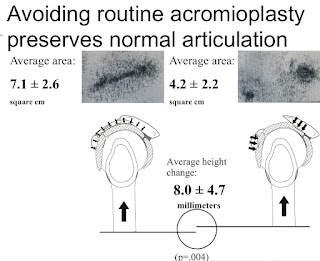These authors noted that coracoacromial ligament (CAL) excision and acromioplasty increase superior and anterosuperior glenohumeral translation. In 9 cadaver shoulders they found that at 150 to 200 N of anterosuperior loading, CAL excision and acromioplasty increased the rotator cuff force required to maintain normal glenohumeral biomechanics by 25% to 30%.
Comment: We always like to recall the quote from the father of shoulder surgery:
In a series of our own experiments (including one in which loads were measured in vivo) we were able to show that superiorly directed loads applied to the humerus were proportionally resisted by loading of the acromion
In another experiment we showed that acromioplasty was followed by 8 mm of superior translation and increased contact pressure (decreased contact area) with the residual acromion.
The combination of acromioplasty and cuff deficiency can lead to anterosuperior escape.
More on the importance of the coracoacromial arch can be seen on this link.
The bottom line is that the CA arch provides important superior stability to the shoulder.
===
Check out the new Shoulder Arthritis Book - click here.
Use the "Search" box to the right to find other topics of interest to you.
You may be interested in some of our most visited web pages including:shoulder arthritis, total shoulder, ream and run, reverse total shoulder, CTA arthroplasty, and rotator cuff surgery as well as the 'ream and run essentials'




